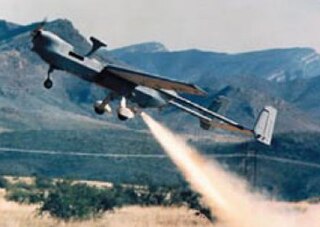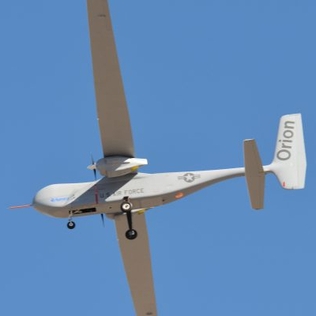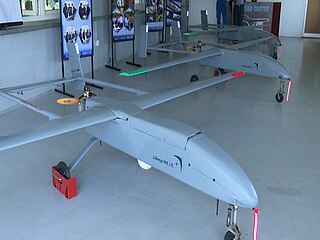
The RQ-3 DarkStar is an unmanned aerial vehicle (UAV). Its first flight was on March 29, 1996. The Department of Defense terminated DarkStar in January 1999, after determining the UAV was not aerodynamically stable and was not meeting cost and performance objectives.

The AAI RQ-2 Pioneer is an unmanned aerial vehicle (UAV) that was used by the United States Navy, Marine Corps, and Army, and deployed at sea and on land from 1986 until 2007. Initially tested aboard USS Iowa, the RQ-2 Pioneer was placed aboard Iowa-class battleships to provide gunnery spotting, its mission evolving into reconnaissance and surveillance, primarily for amphibious forces.

The IAI RQ-5 Hunter is an unmanned aerial vehicle (UAV) originally intended to serve as the United States Army's Short Range UAV system for division and corps commanders. It took off and landed on runways. It used a gimbaled EO/IR sensor to relay its video in real time via a second airborne Hunter over a C-band line-of-sight data link. The RQ-5 is based on the Hunter UAV that was developed by Israel Aerospace Industries.

The AAI RQ-7 Shadow is an American unmanned aerial vehicle (UAV) used by the United States Army, Australian Army, Swedish Army, Turkish Air Force and Italian Army for reconnaissance, surveillance, and target acquisition and battle damage assessment. Launched from a trailer-mounted pneumatic catapult, it is recovered with the aid of arresting gear similar to jets on an aircraft carrier. Its gimbal-mounted, digitally stabilized, liquid nitrogen-cooled electro-optical/infrared (EO/IR) camera relays video in real time via a C-band line-of-sight data link to the ground control station (GCS).

The General Atomics Gnat is an aerial reconnaissance UAV developed in the United States in the late 1980s and manufactured by General Atomics Aeronautical Systems (GA-ASI). As initially designed, it was a simplified version of the LSI Amber intended for foreign sales. The Gnat 750 made its first flight in 1989.
The Yarará project is the first unmanned aerial vehicle (UAV) programme in South America to be produced in series and for export. The system is developed by Nostromo Defensa for surveillance, border patrol and reconnaissance. It was unveiled at the Argentine Air Force Air Show on 10 August 2006. The manufacturer says it has been produced in small series for export to an unidentified government customer in the United States.

NITI is a very light-weight, stealthy remote-controlled Bulgarian unmanned aerial vehicle (UAV). It has been designed and constructed in 2006 by Armstechno Ltd. It mounts a color surveillance camera, a thermal vision camera, and has an option for adding chemical and radioactive contamination dosimeters. Its main tasks are air surveillance of contaminated areas, regions with possible terrorist group activity, artillery correction or observation of natural disaster-stricken areas. NITI has a maximum fuel capacity of 38 L. It also has a programmable autopilot system and GPS system.

The DRS RQ-15 Neptune is a reconnaissance UAV developed in the United States in the early years of the 21st century. The design is optimized for operations over water, and is capable of water landings on its flying boat–like hull. The 11.2 kW (15 hp) pusher engine is mounted high to keep it dry during takeoffs and landings. The Neptune can also be launched off a pneumatic catapult and land on a skid. In 2007, one was unsuccessfully launched off the USS Nashville (LPD-13), crashing into the water less than two seconds after lift off.
The CAC K100 is a mini-UAV developed in France in the 1990s. The company sells a reconnaissance variant, the K100/R, and an antiradar loitering attack variant, the K100/A. The K100 is of conventional aircraft configuration, except for an upright vee tail and a pusher propeller. It has no landing gear.

The AeroVironment Wasp III Small Unmanned Aircraft System is a miniature UAV developed for United States Air Force special operations to provide a small, light-weight vehicle to provide beyond-line-of-sight situation awareness. The aircraft is equipped with two on-board cameras to provide real-time intelligence to its operators. It is also equipped with GPS and an Inertial Navigation System enabling it to operate autonomously from takeoff to recovery. It was designed by AeroVironment Inc., and was first added to the Air Force inventory in 2007. There are two Wasp variants: the traditional version that lands on land, and a version that lands into the sea or fresh water. The Air Force accepted the Wasp AE in late May 2012, and the U.S. Marine Corps revealed in January 2013 that they had ordered the Wasp AE. The Wasp AE is designated as the RQ-12A.

The AeroVironment T-20 unmanned aerial vehicle (UAV) is a medium range, composite aircraft capable of internal and external payloads. Launched from a portable catapult, it can be recovered with a shipboard landing system, or belly land on unimproved surfaces. The T-20 carries a retractable gimbal-mounted, digitally stabilized, electro-optical/infrared (EO/IR) camera that relays video in real time via a C-band LOS data link to the ground control station (GCS). Powered by a 4-stroke, fuel injected gasoline engine, the aircraft burns 2 lb (910 g) of fuel per hour at cruise. AeroVironment, Inc. acquired Arcturus UAV, the original developer of JUMP 20 and T-20 on February 22, 2021.
The BPL Pegaz 011 is a tactical unmanned aerial vehicle prototype developed at the Military Engineering Institute, premiered at the 2011 Partner Arms Fair.

The Boeing Insitu RQ-21 Blackjack, company name Integrator, is an American unmanned air vehicle designed and built by Boeing Insitu to meet a United States Navy requirement for a small tactical unmanned air system (STUAS). It is a twin-boom, single-engine monoplane, designed as a supplement to the Boeing Scan Eagle. The Integrator weighs 61 kg (134 lb) and uses the same launcher and recovery system as the Scan Eagle.

Singular Aircraft is a company with over 10 year experience dedicated to the design, development and manufacturing of Unmanned Aerial Systems (UAS).

The HESA Hamaseh is an Iranian tactical and reconnaissance unmanned aerial vehicle (UAV) with high flight endurance built by Iran Aircraft Manufacturing Industrial Company (HESA). The Hamaseh was unveiled in 2013 and entered service in 2016.

The Orion is a Medium-altitude long-endurance unmanned aerial vehicle (UAV) developed by Aurora Flight Sciences.

Cardinal is a family of small unmanned aerial vehicles made by the National Chung-Shan Institute of Science and Technology (NCSIST).

The Luch Korsar is a medium-weight Russian unmanned aerial vehicle developed by OKB Luch, member of Ruselectronics owned by Rostec, to perform reconnaissance, strike and electronic attack missions on behalf of the Russian Ground Forces and Navy. The program started in 2009 and the flight testing commenced in 2015. It is considered as an improved analogue of the US-made RQ-7 Shadow UAV.

The Lihiniya MK 1 is an unmanned aerial vehicle under development by the Sri Lanka Air Force (SLAF) and the Centre for Research and Development (CRD) as an experimental platform to test technologies for its indigenous UAV program.

The KAI RQ-101 Songgolmae is a South Korean military unmanned aerial vehicle (UAV) developed by the Agency for Defense Development (ADD) and the Korea Aerospace Industries (KAI) in 2000. RQ-101 is an unarmed UAV designed for corps commanders and has been deployed and serviced by the South Korean Army since 2002 to collect military intelligence. It was officially given the name Songgolmae.

















